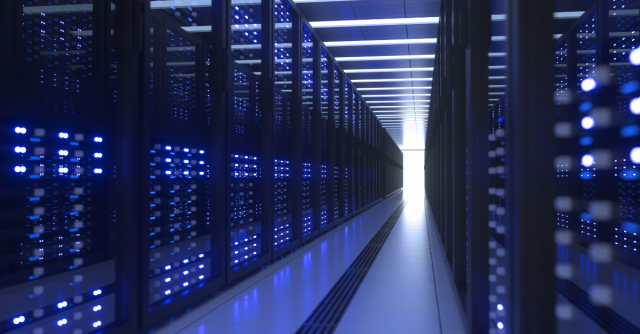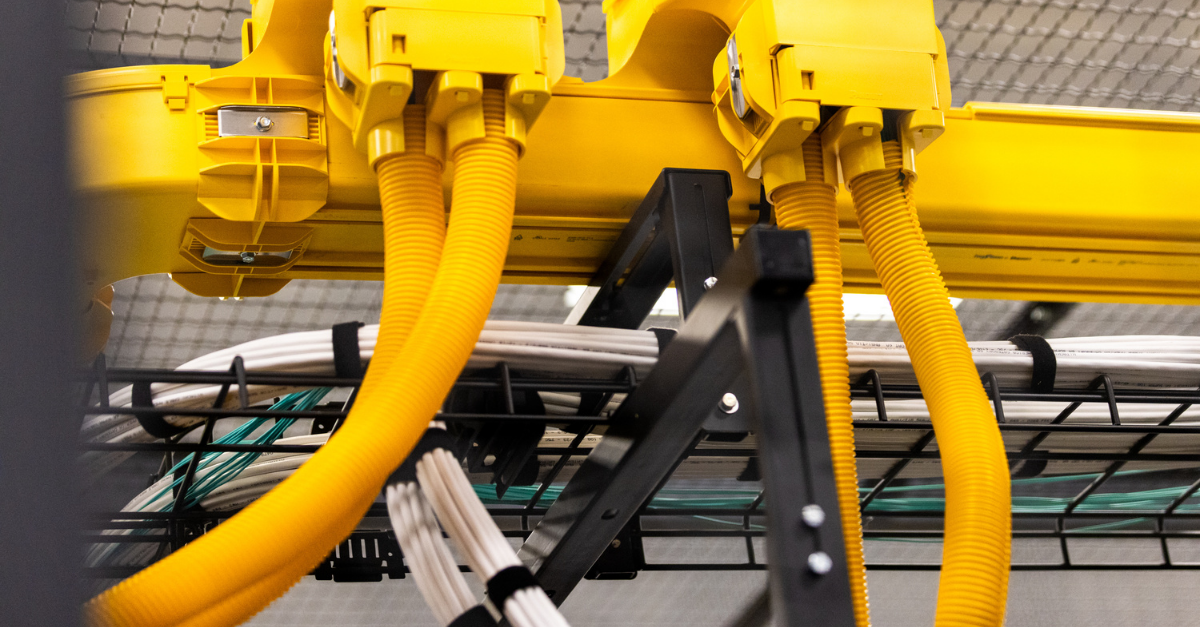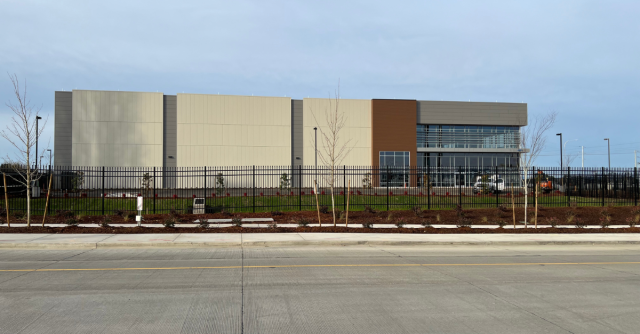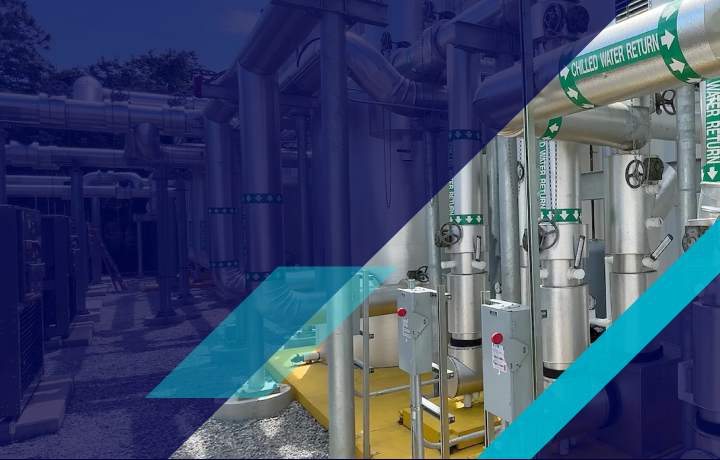What is a high-density data center, and why is it important?
At the intersection of escalating data demands and finite space, a high-density data center stands tall—but what is a high-density data center exactly? It’s a modern hub designed to maximize computing power in a compact footprint, balancing high energy consumption and efficient cooling. As we dig into the characteristics that define these pivotal pieces of infrastructure, we’ll shed light on why their efficiency and advanced engineering are crucial for businesses grappling with the ever-growing tide of digital information.

Understanding data center core concepts
Before diving into the specifics of high-density data centers, it’s important to understand the basic building blocks of any data center—physical density and power density. These components form the backbone of what defines a data center, determining its capacity, efficiency, and overall performance, and are core to helping you choose the right data center provider.
Understanding data center physical density
When we talk about physical density in the context of data centers, we’re referring to the amount of computing power packed into a given space. High-density data centers measure power draw per rack or per square foot to manage and optimize energy usage effectively. This approach allows for efficient resource allocation and performance monitoring.
The standards and best practices in data centers have evolved over time. Today, a density of 10 kW per rack is common, with some high-density data centers adopting 15/25 kW racks. This means that high-density data centers can pack more power—and, therefore, more data—into a smaller space, consolidating resources and enhancing efficiency.
Understanding data center power density
Another key concept in data center architecture is power density. Power density refers to the amount of electrical power consumed by a data center per unit of space, typically measured in kilowatts per cabinet.
What is a high-density data center?
Now that we’ve covered the core concepts of data centers let’s focus on high-density data centers. A high-density data center is a facility that houses a large amount of computing power in a compact space. These data centers are designed to provide cost savings, efficiency, and scalability for modern businesses, making them an ideal solution for tackling the data demands of today’s digital landscape.
Key characteristics of a high-density data center
High-density data centers have certain key characteristics that set them apart from traditional data centers. First, they make efficient use of power. Their high-power density means they can handle larger amounts of data per unit of space, reducing energy costs. Power densities in high-density data centers can range from 40 kW to 125 kW per cabinet, with extreme-density racks going even higher.
Second, high-density data centers employ advanced cooling systems. These systems, such as the hybrid air/liquid cooling setups mentioned earlier, help manage the heat generated by the high computing power. This not only improves performance but also extends the lifespan of the equipment.
Cooling systems in focus
Efficient cooling is crucial in high-density data centers to manage the substantial heat generated by servers. This helps prevent hardware failure and improve overall performance. With today’s compute servers drawing up to 1 kW per rack unit and flash storage up to 600 watts per rack unit, more efficient cooling solutions are needed. Some effective cooling solutions for high-density data centers include:
- Hot aisle/cold aisle containment
- In-row cooling
- Rear door heat exchangers
- Liquid cooling systems
Knowing the importance of cooling in data centers can help ensure that your data center remains cool and efficient, even with high-density server configurations.
The evolution of high-density data centers
High-density data centers did not emerge overnight. They are the result of decades of innovation and development in the data center industry, evolving from large, room-filling systems to compact, efficient facilities. Technological advancements and the growing need for data storage and processing have driven this evolution.
The transition from traditional to high-density data centers
Significant milestones have marked the transition from traditional to high-density data centers. For instance, the introduction of the transistor and the commercial computer in the 1960s and the Intel microprocessor in 1971 led to a dramatic reduction in the size of computational systems.
As technology continued to advance, early bulky storage shifted towards modern compact devices with larger capacities. Servers that once operated at a power capacity of 3-5 kW now function at about 10 kW, signifying a significant enhancement in data center power density.
Innovations driving the growth of high-density data centers
Several innovations have been driving the growth of high-density data centers. These include:
- The rise of the internet
- The proliferation of personal computers in the 1980s and 1990s
- The expansion of data requirements
- The rise of enterprise-owned data centers equipped with air-cooling
However, the most significant catalyst for the growth of high-density data centers has been the rise of High Performance Computing (HPC) across multiple domains. HPC necessitates high-density data centers to handle the surge in data and internet traffic, positioning these data centers as key to future data storage.
Why are high-density data centers important?
With an understanding of what high-density data centers are and how they’ve evolved, let’s delve into why they are so important. High-density data centers offer numerous benefits, including:
- Operational advantages
- Cost and space savings
- Enhanced performance and reliability
- Scalability and flexibility
Operational advantages of high-density data centers
One of the primary advantages of high-density data centers is their operational efficiency. By scaling server capacity without exponentially increasing costs related to security, cooling, and storage space, these data centers significantly reduce real estate expenses.
Energy efficiency is another key operational advantage. High-density data centers minimize power waste and maximize the productive use of electrical energy, contributing to data center efficiency. The ability to pack more power into a compact setup allows for a higher client density, easier management, and scalability while controlling cabling complexities. In this context, power usage efficiency plays a significant role in the overall performance of high-density data centers.
Cost and space-saving benefits
High-density data centers offer substantial cost and data center space savings, as well as reduced floor space requirements, compared to low-density data centers. They require less physical space, reducing real estate or rental expenses. For instance, AutoNation was able to condense a 20-cabinet setup down to seven cabinets with higher per-cabinet capacity after migrating to a high-density data center.
Resource consolidation into high-density racks leads to:
- Reduced operational costs
- Optimized data center’s financial overhead
- Reduction in the quantity of cabling needed
- Reduction in costs associated with cabling installation
Enhanced performance and reliability
Enhanced performance and reliability are other key benefits of high-density data centers. High-performance computing and artificial intelligence requirements are driving these data centers towards extreme-density racks, with a reliable operational capacity ranging from 40 kW to 200 kW per rack.
Moreover, the incorporation of advanced processors designed for AI and machine learning applications has led to significant increases in power requirements per rack, with some CPUs consuming up to 400 W and GPUs for AI reaching 1000 W each. To manage this heat load, high-density data centers are increasingly adopting highly efficient cooling techniques, such as liquid cooling, which can improve hardware performance and longevity.
Scalability and flexibility
Scalability and flexibility are crucial benefits of high-density data centers. These data centers are designed to easily expand and adapt to changing business needs. This is particularly important in today’s rapidly evolving digital landscape, where businesses must be able to:
- Scale up their data storage and processing capabilities quickly and efficiently
- Handle increasing amounts of data and traffic
- Support new technologies and applications
- Accommodate future growth and expansion
High-density data centers provide the data center infrastructure and resources necessary to meet these demands, ensuring that businesses can stay competitive and agile in the digital age. Moreover, high-density data centers offer the following benefits:
- Flexibility to accommodate a wide range of workloads
- Ideal solution for businesses that need to handle large amounts of data or run complex applications
- Scalability and flexibility help businesses stay competitive in a data-driven world.
The implications of high data center density
High data center density, while offering numerous benefits, also has its implications. This includes both advantages and challenges, such as improved efficiency, reduced costs, and the need for advanced cooling systems.
Advantages of high data center density
High data center density offers several advantages. One of the most significant is the consolidation of servers through virtualization, which optimizes resource utilization and significantly reduces energy consumption.
By reducing the amount of physical hardware through server virtualization, data centers can achieve lowered power and cooling costs, enhancing overall energy efficiency. Furthermore, virtualization provides a safety net against hardware failure, ensuring continuity and stability within the high-density data center environment.
Challenges of high data center density
While high data center density brings many advantages, it also presents certain challenges. One of these is the need for advanced cooling systems to manage the increased heat generated by higher computing power.
Liquid cooling, while not new, is considered the future of thermal management in high-density data centers, and it is more efficient than air cooling due to its higher thermal transfer properties. However, implementing such systems requires careful space planning, layout, and monitoring of infrastructure costs to support the needs of the computing environment.
Future trends in high-density data centers and scalability
As we look ahead, several trends are shaping the future of high-density data centers. These include:
- The focus on disaster recovery and business continuity
- The shift towards green and sustainable data centers
- The integration of artificial intelligence and machine learning in data center management
Disaster recovery and business continuity
With the increasing frequency and severity of natural disasters over the past twenty years, the necessity for robust disaster recovery strategies in high-density data centers has dramatically escalated. Backup power is a crucial backbone for these strategies, designed to safeguard technological environments during crises.
Moreover, business continuity involves maintaining essential data center operations and services during and following a disaster. This necessitates comprehensive disaster preparedness, which is reliant on backup power capabilities. Read more about Business Continuity and Disaster Recovery (BCDR) here.
Green and sustainable data centers
Another key trend in the data center industry is the shift towards green and sustainable data centers. These data centers focus on energy efficiency, reducing their environmental impact, and utilizing renewable energy sources.
In addition to reducing operational costs, green data centers also help businesses meet their corporate social responsibility objectives. With the increasing focus on sustainability in today’s business landscape, the trend towards green and sustainable data centers is likely to continue in the years to come.
The role of AI and machine learning in data centers management
Artificial intelligence (AI) and machine learning are playing an increasingly important role in data center management. These technologies can help optimize operational tasks within data centers, supporting the transition to higher density and more efficient rack configurations.
By automating routine tasks, AI and machine learning can free up data center staff to focus on more strategic tasks. Moreover, these technologies can help enhance the performance and reliability of data centers, making them a key part of the future of high-density data centers.
Join us for a dynamic, forward-looking discussion illuminating the evolving landscape of artificial intelligence and its profound impact on data center technology and strategies.
Join Flexential leaders Jason Carolan, CIO, Ryan Mallory, COO, and Pat Doherty, CRO, for a unique, on-demand webinar, Data centers in the AI era, to gain expert insights on how AI trends are impacting the data center industry.
Flexential and our high-density data centers
In conclusion, high-density data centers represent a significant advancement in the data center industry. By packing more computing power into a smaller space, these data centers offer numerous benefits, including operational efficiency, cost and space savings, enhanced performance and reliability, and scalability and flexibility.
At Flexential, we’ve been at the forefront of the high-density data center revolution. With a 20-year track record, we’ve helped businesses across various industries leverage the power of high-density data centers to achieve their goals.
A leader in high-density by design
Flexential high-density data centers are designed for efficiency, performance, and adaptability. We take a strategic approach to data center design, focusing on scalability, security, and sustainability.
Our high-density data centers are equipped with advanced cooling systems and power-efficient infrastructure, enabling us to deliver superior performance while minimizing environmental impact. We’re proud to be a leader in high-density colocation, and we’re committed to helping our clients reap the benefits of this innovative technology.
Looking ahead, we’re even more excited about the future with the announcement of Flexential Hillsboro 5, the latest high-density data center in the Portland market, built to support today’s AI/ML requirements, providing up to 80+ kW per cabinet and liquid-ready infrastructure.
As we navigate the digital age, the importance of high-density data centers will only continue to grow. Whether you’re looking to reduce operational costs, enhance performance, or scale your data storage capabilities, high-density data centers offer a powerful solution. Here at Flexential, we’re excited to be part of this revolution, and we look forward to helping you leverage the power of high-density data centers.
Explore our high-density data centers and colocation solutions, or book a tour today!







